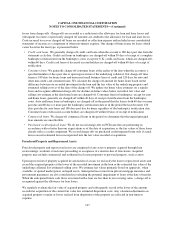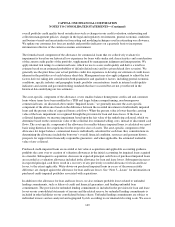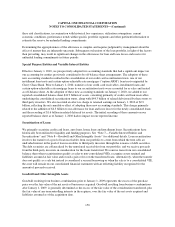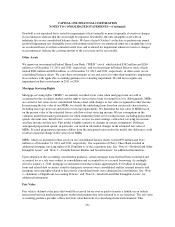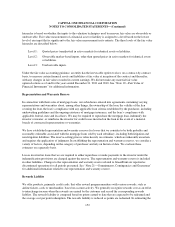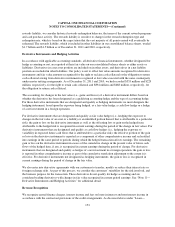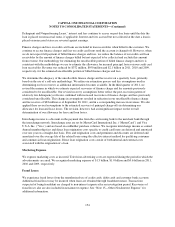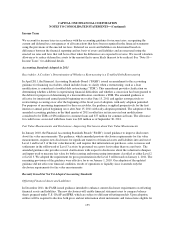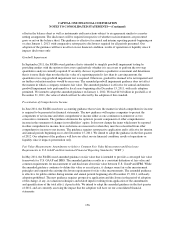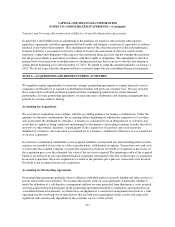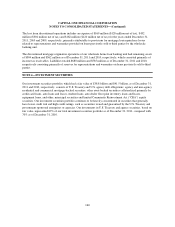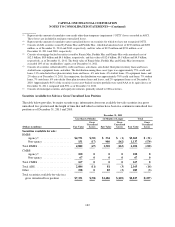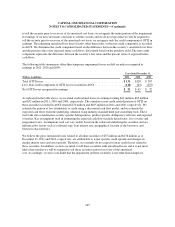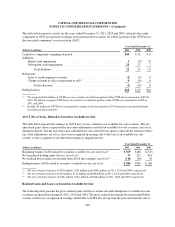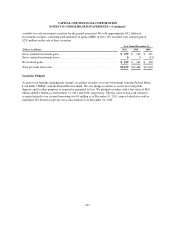Capital One 2011 Annual Report Download - page 177
Download and view the complete annual report
Please find page 177 of the 2011 Capital One annual report below. You can navigate through the pages in the report by either clicking on the pages listed below, or by using the keyword search tool below to find specific information within the annual report.
CAPITAL ONE FINANCIAL CORPORATION
NOTES TO CONSOLIDATED STATEMENTS—(Continued)
Transfers and Servicing: Reconsideration of Effective Control for Repurchase Agreements
In April 2011, the FASB issued an amendment to the guidance for transfers and servicing with regard to
repurchase agreements and other agreements that both entitle and obligate a transferor to repurchase or redeem
financial assets before their maturity. This amendment removes the criterion related to collateral maintenance
from the transferor’s assessment of effective control. It focuses the assessment of effective control on the
transferor’s rights and obligations with respect to the transferred financial assets and not whether the transferor
has the practical ability to perform in accordance with those rights or obligations. The amendment is effective
prospectively for transactions or modification of existing transactions that occur on or after the first interim or
annual period beginning on or after December 15, 2011. We intend to adopt the amended guidance on January 1,
2012. We do not expect that the adoption will have a material impact on our consolidated financial statements.
NOTE 2—ACQUISITIONS AND RESTRUCTURING ACTIVITIES
We regularly explore opportunities to enter into strategic partnership agreements or acquire financial services
companies and businesses to expand our distribution channels and grow our customer base. We may structure
these transactions with both an initial payment and later contingent payments tied to future financial
performance. In some partnership agreements, we may enter into collaborative risk-sharing arrangements that
provide for revenue and loss sharing.
Accounting for Acquisitions
We account for acquisitions in accordance with the accounting guidance for business combinations. Under the
guidance for business combinations, the accounting differs depending on whether the acquired set of activities
and assets meets the definition of a business. A business is considered to be an integrated set of activities and
assets that is capable of being conducted and managed for the purpose of providing economic benefits directly to
investors or other owners, members, or participants. If the acquired set of activities and assets meets the
definition of a business, the transaction is accounted for as a business combination. Otherwise, it is accounted for
as an asset acquisition.
In a business combination, identifiable assets acquired, liabilities assumed and any noncontrolling interest in the
acquiree are recorded at fair value as of the acquisition date, with limited exceptions. Transaction costs and costs
to restructure the acquired company are generally expensed as incurred. Goodwill is recognized as the excess of
the acquisition price over the estimated fair value of the net assets acquired. The operating results of the acquired
business are reflected in our consolidated financial statements subsequent to the date of the merger or acquisition.
In an asset acquisition, the assets acquired are recorded at the purchase price plus any transaction costs incurred.
Goodwill is not recognized in an asset acquisition.
Accounting for Partnership Agreements
Our partnership agreements primarily relate to alliances with third parties to provide lending and other services to
private label credit card customers. We evaluate the specific terms of each agreement to determine whether it
meets the definition of a collaborative arrangement and how revenue generated from third parties, costs incurred
and transactions between participants in the partnership agreement should be accounted for and reported in our
consolidated financial statements. A collaborative arrangement is a contractual arrangement that involves a joint
operating activity involving two or more parties that are both active participants in the activity and exposed to
significant risks and rewards dependent on the economic success of the activity.
157


